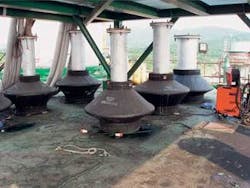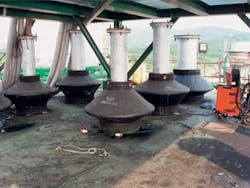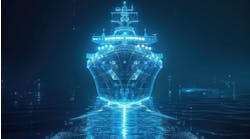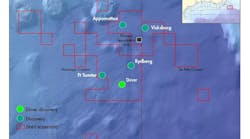RUBBER/POLYMER DEVELOPMENTS: Trelleborg/CRP merger creates leader in offshore polymer/buoyancy systems
Nick Terdre, Contributing Editor
Trelleborg Engineered Systems, which supplies products and services to the offshore sector based on its polymer rubber technology, has extended its expertise and product line through the acquisition of the CRP group. Oil and gas related operations in the Trelleborg group will increase to 7-8% of overall sales.
CRP is a UK and US-based engineering company working with polymer products, and specializing in epoxy and polyurethane materials. It supplies systems for seismic surveys, drilling operations and subsea production, including solutions for deepwater flow assurance and buoyancy systems.
The two companies’ products are largely complementary, according to Lennart Johansson, president of Trelleborg Engineered Systems. “So far we at Trelleborg have only addressed the production side,” he says. “CRP brings us access to drilling and exploration areas, as well. We think this will make us the world leader in polymer solutions for the offshore market.”
Even before the take-over became a reality, the two companies worked together on what has now become Trelleborg’s latest offshore product. This is Trelline, a flexible rubber and steel hose system for offloading crude from FPSO to tanker via a Calm buoy, which for safety reasons is typically located a couple of kilometers distant. Using buoyancy elements, the hose is suspended in the water at a safe depth. Trelleborg is responsible for the hose and CRP for the buoyancy elements.
The first order for a Trelline system, worth EUR 10 m, has been secured for an FPSO project in West Africa. Compared with the flexible pipelines used for this purpose, Trelleborg claims various advantages for its product, such as weight, flexibility, insulation characteristics, resistance to fatigue and corrosion, and low-cost installation and maintenance.
According to Alan Wilson, former head of CRP and now president of the Trelleborg CRP business unit, the newly enlarged group has won orders for subsea equipment in Norway which comprise a mixture of CRP and Trelleborg products.
The group now has an extensive network of manufacturing plants making products for the offshore sector. In addition to Trelleborg’s facilities in Norway, the Netherlands, France and Singapore, CRP brings plants in the UK and USA.
In the US the former CRP plant in Boston manufactures buoyancy for ROVs and submersibles. In addition to offshore deliveries, it also supplied buoyancy for the submersible which found the wreck of Titanic, and more recently for a Chinese-owned manned submersible capable of diving to 7,000 m. The plant makes its own glass microspheres for syntactic buoyancy blocks.
The Houston plant is responsible for manufacturing buoyancy for risers. There is a lot of pressure from the industry for more efficient buoyancy with less overall weight for deepwater applications, Wilson says. Another of its products is protection elements in polymer for the laydown of risers and dynamic umbilicals on the seabed. The plant also applies polymer insulation coatings to pipelines and subsea equipment.
Pipeline coatings using rubber are done by the Norwegian subsidiary, Trelleborg Viking, which has a plant located close to Oslo. It can also provide rubber coatings for unusually shaped structures.
Trelleborg currently has a strong orderbook. One recent delivery which caught the headlines was the supply of 156 jet-fire seals to the Sakhalin II project off the east coast of Russia. The seals are installed at strategic locations on the two concrete-base platforms as a protective barrier to delay the spread of fire. Each seal is 1m high and 2.5 m wide, and because of the high risk of earthquakes in the area, has to be capable of withstanding movements of up to 600mm. The seals were designed and manufactured by Trelleborg Viking.
Another leading product is Elastopipe, a patented piping system designed for deluge and sprinkler systems in harsh environments. Made of synthetic rubber, it can withstand a jet-fire for more than two hours while still allowing liquids to run through it. CNR International has awarded Trelleborg a contract to install Elastopipe as part of an upgrade of the firewater systems on its Ninian platforms in the UK sector of the North Sea. Other North Sea operators, including BP, ConocoPhillips, Maersk, Norsk Hydro, Shell and Statoil, have also installed Elastopipe on their platforms.
A growth area over the last five years, driven by the growing number of high-pressure, high-temperature fields coming up for development, has been thermal insulation for subsea production equipment such as templates and manifolds. Where it is inconvenient to take the equipment requiring thermal insulation to the Trelleborg plant, a site team can come to the production or storage place and do the job with mobile facilities.
A new area which Johansson says is likely to provide growing business for Trelleborg is LNG transportation. He sees demand from this sector for thermal insulation products and hoses. The company is already bidding thermal products for offshore regasification plants, and developing hoses for LNG transfer at a temperature of -163°C.
For more information contact Lennart Johansson, Trelleborg Engineered Systems Group. Tel +46 410 51020, fax +46 410 715121,[email protected], www.trelleborg.com




